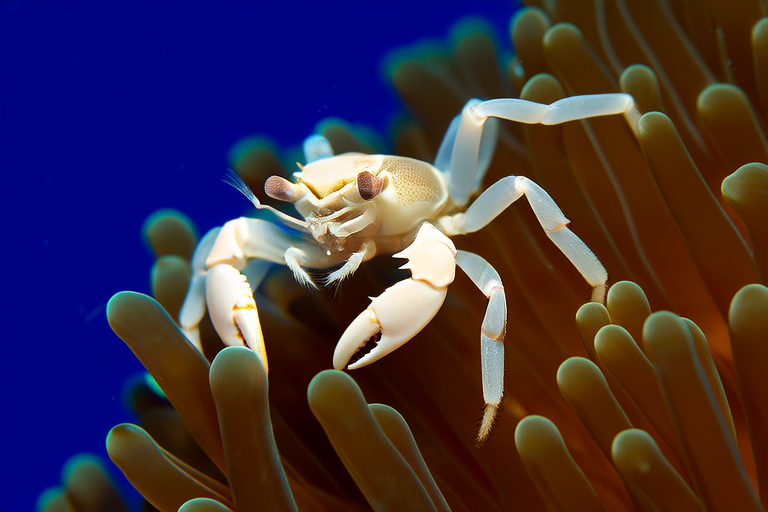The Hidden Lives of Pea Crabs and Sea Anemones: A Symbiotic Underwater Tale
In the vast and mysterious ocean, there exists a delicate dance of life where two seemingly disparate creatures, the pea crab and the sea anemone, share a unique symbiotic relationship. This underwater ballet is a testament to nature’s ingenuity, where both organisms find refuge, sustenance, and protection within each other. Let us delve into the hidden lives of these tiny inhabitants, exploring their mutual benefits, habitat specifics, the challenges they face, and recent scientific discoveries that shed light on their intricate coexistence.
The Pea Crab: A Tiny Yet Mighty Dancer
Pea crabs, named for their small size resembling a pea, are diminutive crustaceans that inhabit the ocean’s depths. These petite creatures, typically measuring no more than a few centimeters in length, are known for their translucent shells, which allow them to blend seamlessly with their surroundings. Their delicate pincers and elongated bodies enable them to navigate through the intricate architecture of sea anemones with ease. The pea crab’s slender form is a marvel of evolution, perfectly adapted to its role as a symbiont.
The Sea Anemone: A Garden of the Deep
Sea anemones, on the other hand, are stationary marine animals that resemble flowers with their vibrant colors and tentacles. They anchor themselves to rocks, coral reefs, or even the undersides of boats, creating a serene yet dynamic environment. These cnidarians are masters of camouflage, utilizing their ability to change color to match their surroundings, making them nearly invisible to predators. Their tentacles, lined with stinging cells called nematocysts, serve as both a defense mechanism and a means of capturing prey. The sea anemone’s habitat is a bustling microcosm, teeming with life, where the pea crab finds its sanctuary.
A Dance of Mutual Benefits
The relationship between pea crabs and sea anemones is one of mutualism, where both parties benefit from their association. For the pea crab, the sea anemone provides a safe haven from larger predators and a steady supply of food. The crab’s small size allows it to reside within the anemone’s body cavity, protected by the anemone’s potent tentacles. Additionally, the pea crab feeds on the anemone’s leftover food particles, such as plankton and small fish, ensuring a constant source of nourishment. In return, the pea crab offers a service to the anemone by grooming it, removing debris and parasites that could otherwise harm the host. This mutualistic relationship is a prime example of how cooperation can lead to survival in the harsh realities of the ocean.
Habitat Specifics: A World of Wonders
The habitats of pea crabs and sea anemones are as diverse as they are fascinating. From shallow coastal waters to the deep abyssal plains, these creatures have adapted to a wide range of environments. Many species of sea anemones are found in rocky intertidal zones, where they cling tenaciously to the substrate despite the pounding waves. Others thrive in the vibrant coral reefs, where they form part of the intricate web of life. Some species even live in the cold, dark waters of the deep sea, where the pressure is immense and the temperature is near freezing. Despite the varied habitats, the symbiotic relationship between pea crabs and sea anemones remains consistent, showcasing the adaptability of nature.
Challenges in the Underwater World
Life in the ocean is fraught with challenges, and both pea crabs and sea anemones face numerous threats to their survival. Climate change poses a significant danger, as rising water temperatures and ocean acidification can disrupt the delicate balance of their ecosystems. Changes in pH levels can weaken the calcium carbonate structures of both the pea crabs’ shells and the sea anemones’ skeletons, leaving them vulnerable to predation and disease. Additionally, pollution and overfishing can have cascading effects on the food chain, reducing the availability of prey for the pea crabs and disrupting the overall health of the marine environment.
Recent Scientific Discoveries: Unveiling the Secrets of Symbiosis
Advancements in technology and research have provided new insights into the complex relationship between pea crabs and sea anemones. Recent studies have revealed that the pea crabs release chemicals that signal to the anemone, promoting the growth of beneficial bacteria on the anemone’s surface. These bacteria help protect the anemone from harmful pathogens, further enhancing the mutualistic relationship. Scientists have also discovered that the presence of pea crabs can influence the reproductive success of sea anemones, as the crabs may assist in the dispersal of anemone larvae. These findings underscore the intricate nature of symbiosis and highlight the importance of studying these relationships to better understand marine ecosystems.
The Future of Pea Crabs and Sea Anemones
As our understanding of the ocean continues to grow, it is crucial to recognize the vital role that symbiotic relationships play in maintaining biodiversity. Conservation efforts must focus on protecting the habitats of pea crabs and sea anemones, ensuring that these delicate partnerships can thrive for generations to come. By addressing the challenges posed by climate change, pollution, and overfishing, we can safeguard the future of these remarkable creatures and the vibrant underwater world they inhabit. The dance between pea crabs and sea anemones is a reminder of the beauty and complexity of life in the ocean, and it is our responsibility to preserve this wondrous spectacle for future generations.
